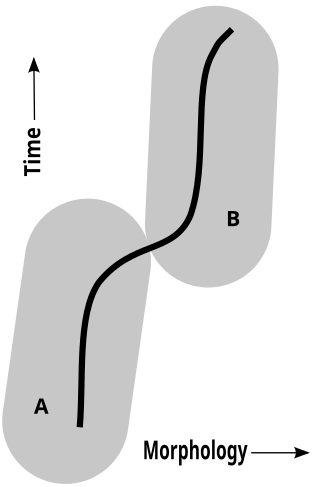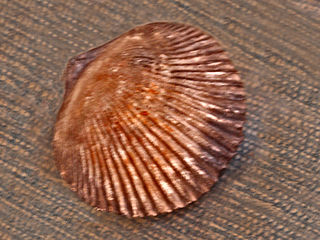Related Research Articles

Stratigraphy is a branch of geology concerned with the study of rock layers (strata) and layering (stratification). It is primarily used in the study of sedimentary and layered volcanic rocks. Stratigraphy has three related subfields: lithostratigraphy, biostratigraphy, and chronostratigraphy.

Biostratigraphy is the branch of stratigraphy which focuses on correlating and assigning relative ages of rock strata by using the fossil assemblages contained within them. The primary objective of biostratigraphy is correlation, demonstrating that a particular horizon in one geological section represents the same period of time as another horizon at a different section. Fossils within these strata are useful because sediments of the same age can look completely different, due to local variations in the sedimentary environment. For example, one section might have been made up of clays and marls, while another has more chalky limestones. However, if the fossil species recorded are similar, the two sediments are likely to have been laid down around the same time. Ideally these fossils are used to help identify biozones, as they make up the basic biostratigraphy units, and define geological time periods based upon the fossil species found within each section.
A stratigraphic unit is a volume of rock of identifiable origin and relative age range that is defined by the distinctive and dominant, easily mapped and recognizable petrographic, lithologic or paleontologic features (facies) that characterize it.

A chronospecies is a species derived from a sequential development pattern that involves continual and uniform changes from an extinct ancestral form on an evolutionary scale. The sequence of alterations eventually produces a population that is physically, morphologically, and/or genetically distinct from the original ancestors. Throughout the change, there is only one species in the lineage at any point in time, as opposed to cases where divergent evolution produces contemporary species with a common ancestor. The related term paleospecies indicates an extinct species only identified with fossil material. That identification relies on distinct similarities between the earlier fossil specimens and some proposed descendant although the exact relationship to the later species is not always defined. In particular, the range of variation within all the early fossil specimens does not exceed the observed range that exists in the later species.

Lithostratigraphy is a sub-discipline of stratigraphy, the geological science associated with the study of strata or rock layers. Major focuses include geochronology, comparative geology, and petrology.

Relative dating is the science of determining the relative order of past events, without necessarily determining their absolute age. In geology, rock or superficial deposits, fossils and lithologies can be used to correlate one stratigraphic column with another. Prior to the discovery of radiometric dating in the early 20th century, which provided a means of absolute dating, archaeologists and geologists used relative dating to determine ages of materials. Though relative dating can only determine the sequential order in which a series of events occurred, not when they occurred, it remains a useful technique. Relative dating by biostratigraphy is the preferred method in paleontology and is, in some respects, more accurate. The Law of Superposition, which states that older layers will be deeper in a site than more recent layers, was the summary outcome of 'relative dating' as observed in geology from the 17th century to the early 20th century.

In biostratigraphy, biostratigraphic units or biozones are intervals of geological strata that are defined on the basis of their characteristic fossil taxa, as opposed to a lithostratigraphic unit which is defined by the lithological properties of the surrounding rock.
In geology, a sequence is a stratigraphic unit which is bounded by an unconformity at the top and at the bottom.

The Dakota is a sedimentary geologic unit name of formation and group rank in Midwestern North America. The Dakota units are generally composed of sandstones, mudstones, clays, and shales deposited in the Mid-Cretaceous opening of the Western Interior Seaway. The usage of the name Dakota for this particular Albian-Cenomanian strata is exceptionally widespread; from British Columbia and Alberta to Montana and Wisconsin to Colorado and Kansas to Utah and Arizona. It is famous for producing massive colorful rock formations in the Rocky Mountains and the Great Plains of the United States, and for preserving both dinosaur footprints and early deciduous tree leaves.
The European Land Mammal Mega Zones are zones in rock layers that have a specific assemblage of fossils (biozones) based on occurrences of fossil assemblages of European land mammals. These biozones cover most of the Cenozoic, with particular focus having been paid to the Neogene and Paleogene systems, the Quaternary has several competing systems. In cases when fossils of mammals are abundant, stratigraphers and paleontologists can use these biozones as a more practical regional alternative to the stages of the official ICS geologic timescale. European Land Mammal Mega Zones are often also confusingly referred to as ages, stages, or intervals.

The Tropic Shale is a Mesozoic geologic formation. Dinosaur remains are among the fossils that have been recovered from the formation, including Nothronychus graffami. The Tropic Shale is a stratigraphic unit of the Kaiparowits Plateau of south central Utah. The Tropic Shale was first named in 1931 after the town of Tropic where the Type section is located. The Tropic Shale outcrops in Kane and Garfield counties, with large sections of exposure found in the Grand Staircase–Escalante National Monument.

Peregrinella is an extinct Early Cretaceous rhynchonellid genus with scattered, global representation from North America to Europe and Tibet. These brachiopods are stationary epifaunal suspension feeders, its most distinguishing feature is the size, considered to be the largest of all Mesozoic rhynchonellids, which has long puzzled paleontologists because of its unusual morphology, stratigraphic occurrence, and distribution patterns.
One of the major depositional strata in the Himalaya is the Lesser Himalayan Strata from the Paleozoic to Mesozoic eras. It had a quite different marine succession during the Paleozoic, as most parts of it are sparsely fossiliferous or even devoid of any well-defined fossils. Moreover, it consists of many varied lithofacies, making correlation work more difficult. This article describes the major formations of the Paleozoic – Mesozoic Lesser Himalayan Strata, including the Tal Formation, Gondwana Strata, Singtali Formation and Subathu Formation.
Accommodation is a fundamental concept in sequence stratigraphy, a subdiscipline of geology. It is defined as the space that is available for the deposition of sediments. Accommodation space can be pictured as the volume between the actual surface and the theoretical equilibrium surface where deposition and erosion are in balance at every point. In marine environments, this equilibrium level is sea level.
A parasequence is a fundamental concept of sequence stratigraphy. Parasequences are not directly related to sequences.
In biostratigraphy, a subdiscipline of geology, a taxon-range zone is the zone between the highest and the lowest stratigraphic occurrence of a taxon. Taxon-range zones are one of the fundamental biozones used in biostratigraphy and are named after the taxon whose range they describe.
In sequence stratigraphy, a maximum flooding surface is the surface that marks the transition from a transgression to a regression. Maximum flooding surfaces are abbreviated by mfs, synonyms for them include final transgressive surface, surface of maximum transgression and maximum transgressive surface.

Steven M. Holland is an American paleontologist and geologist at the University of Georgia. His research focuses on stratigraphic paleobiology, the application of event and sequence stratigraphy to a paleobiological understanding of the fossil record. With Mark Patzkowsky, he coauthored the book Stratigraphic Paleobiology.
In sequence stratigraphy, a sub discipline of geology, type 1 sequences and type 2 sequences are special sequences that are defined by having distinct types of sequence boundaries. In modern literature, the distinction in type 1 sequences and type 2 sequences was abandoned.
Stratigraphic paleobiology is a branch of geology that is closely related to paleobiology, sequence stratigraphy and sedimentology. Stratigraphic paleobiology studies how the fossil record is altered by sedimentological processes and how this affects biostratigraphy and paleobiological interpretations of the fossil record.
References
- ↑ Patzkowsky, Mark E.; Holland, Steven M. (2012). Stratigraphic Paleobiology. Chicago: University of Chicago University Press. p. 94.
- 1 2 Holland, Steven M. (2000). "The quality of the fossil record: a sequence stratigraphic perspective". Paleobiology. The Paleontological Society. 26 (4): 148–168. doi:10.1017/s0094837300026919.